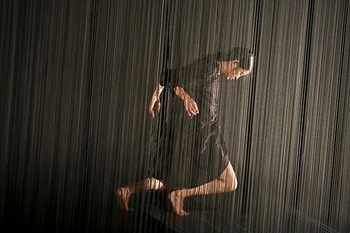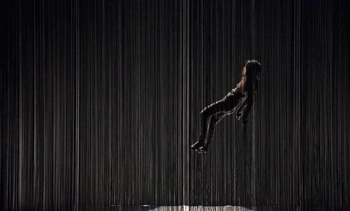(© Mario Del Curto)
For her new solo show, Plexus, co-written with the director Aurélien Bory, the dancer Kaori Ito encloses herself in a complex structure of strings before escaping from them. “It did me good to be confronted with a structure which prevented me from dancing.”
Trained in classical dance since the age of five, Kaori Ito from Japan has become an atypical body of contemporary dance, who has worked with leading European choreographers. Aurélien Bory suggested a solo that would reveal her inner world. To that end, he asked her to make a puppet – an effigy of herself – dance. In the end, they only kept the strings. Within the intertwining in that space, she had to find a different way of moving and of showing herself.
You let yourself be shut inside that network of strings in order to free yourself from gravity?
Kaori Ito: Aurélien’s idea was to place me within maximal constraints in order to see how I could dance. For me, that was a good idea: it did me good to be confronted with that structure, which prevented me from dancing. Technically, it’s very interesting. In that kind of set-up, movements are fairly precise: you have to invent new ways of moving around and dancing. You could see an oppressive aspect to it, but I think that, on the contrary, when one is shut in, one finds in the details things that are liberating. I also believe that when you are completely free, you don’t know what to do. From that point of view, it’s very close to my own philosophy in life. There is good and bad. If there was no bad side, there would be no good side either.
Plexus: Kaori Ito pulls some strings

Is working in that way with strings rich in metaphor?
Ito: Yes, definitely: one can think of a goddess of light in Japanese mythology, who hides herself in a cave. Through the play of perspective, one evokes someone who disappears, reappears, hides herself, and enters and exits from her body. At a more personal level, I wanted a contrast between something mechanical and something that is very human. I wanted to take the flesh, humanity, and emotion into a completely abstract structure.
What have you learned from this show?
Ito: In each show, I learn lots of things. In Plexus, I am entirely alone onstage for an hour, which demands considerable concentration. I discovered that, even if it doesn’t look that way, even if one doesn’t do much, when it can hold up, it does. Which comes down to not showing too much of what I know, and being prepared to listen attentively. Today, I no longer feel the pressure that was there at the beginning of my career to show everything I can do. I think people understand that I can dance, even if I don’t show much. In Plexus, there isn’t any moment that relies on a highly visible technique, but the technique is there in the background. It taught me a lot, because now, at this stage of my career, I don’t need to be demonstrative in my way of being onstage. Dancing alone every evening before 1,000 people, I think I have gained a certain strength and confidence and that has been good for me.
You have danced for leading personalities and you have also devised choreographies of your own. Was that a logical development?
Ito: In fact, that’s how I started. I created my first solo when I was eighteen, because I couldn’t fit in as a performer in the other companies in Japan. My family in Tokyo is a bit unusual: they are all artists. My parents are sculptors and my brother is a painter. I paint too, I do drawings, I make exhibitions and films: I have taken on lots of forms of art since I was little. But after a while, I wanted to learn different things. I knew I would leave Japan pretty soon, because that over-conformist society didn’t suit me. I spent time with Alvin Ailey in New York, and then in Europe I worked with Philippe Decouflé, Angelin Preljocaj, James Thierrée, and Alain Platel. I was like a sort of sponge who wanted to learn lots of things to find inspiration and to create my own way. It was very clear, right from the start, that I wanted to create something.
Ito: Yes, definitely: one can think of a goddess of light in Japanese mythology, who hides herself in a cave. Through the play of perspective, one evokes someone who disappears, reappears, hides herself, and enters and exits from her body. At a more personal level, I wanted a contrast between something mechanical and something that is very human. I wanted to take the flesh, humanity, and emotion into a completely abstract structure.
What have you learned from this show?
Ito: In each show, I learn lots of things. In Plexus, I am entirely alone onstage for an hour, which demands considerable concentration. I discovered that, even if it doesn’t look that way, even if one doesn’t do much, when it can hold up, it does. Which comes down to not showing too much of what I know, and being prepared to listen attentively. Today, I no longer feel the pressure that was there at the beginning of my career to show everything I can do. I think people understand that I can dance, even if I don’t show much. In Plexus, there isn’t any moment that relies on a highly visible technique, but the technique is there in the background. It taught me a lot, because now, at this stage of my career, I don’t need to be demonstrative in my way of being onstage. Dancing alone every evening before 1,000 people, I think I have gained a certain strength and confidence and that has been good for me.
You have danced for leading personalities and you have also devised choreographies of your own. Was that a logical development?
Ito: In fact, that’s how I started. I created my first solo when I was eighteen, because I couldn’t fit in as a performer in the other companies in Japan. My family in Tokyo is a bit unusual: they are all artists. My parents are sculptors and my brother is a painter. I paint too, I do drawings, I make exhibitions and films: I have taken on lots of forms of art since I was little. But after a while, I wanted to learn different things. I knew I would leave Japan pretty soon, because that over-conformist society didn’t suit me. I spent time with Alvin Ailey in New York, and then in Europe I worked with Philippe Decouflé, Angelin Preljocaj, James Thierrée, and Alain Platel. I was like a sort of sponge who wanted to learn lots of things to find inspiration and to create my own way. It was very clear, right from the start, that I wanted to create something.

(© Aurélien Bory)
In Europe, I had a book entitled Les nouvelles danses de France, in which I underlined all the choreographers I wanted to work with. I did, with almost all of them, because I was keen to learn as much as possible in order to create my own way later. From the start, it was clear. On the one hand, there was the fear of dying without leaving anything in the way of traces of creative work, and on the other hand, the desire to experiment with something that one searches for deep inside oneself. I needed that and it took me time. Longer than I thought, as once I had trained as a performer, it wasn’t easy to change hats and be accepted as a choreographer.
What makes you dance?
Ito: I dance because I don’t trust words. That’s also the title of the show I’m working on. I mistrust words because I think that, in Japan, and even here, things are said, but there are lots of truths between the words. At first, because I didn’t understand French, I observed and I tried to understand via movements and gestures and I think it’s that that I trust.
PLEXUS 1 & 2/4, Les Halles de Schaerbeek, www.halles.be
In Europe, I had a book entitled Les nouvelles danses de France, in which I underlined all the choreographers I wanted to work with. I did, with almost all of them, because I was keen to learn as much as possible in order to create my own way later. From the start, it was clear. On the one hand, there was the fear of dying without leaving anything in the way of traces of creative work, and on the other hand, the desire to experiment with something that one searches for deep inside oneself. I needed that and it took me time. Longer than I thought, as once I had trained as a performer, it wasn’t easy to change hats and be accepted as a choreographer.
What makes you dance?
Ito: I dance because I don’t trust words. That’s also the title of the show I’m working on. I mistrust words because I think that, in Japan, and even here, things are said, but there are lots of truths between the words. At first, because I didn’t understand French, I observed and I tried to understand via movements and gestures and I think it’s that that I trust.
PLEXUS 1 & 2/4, Les Halles de Schaerbeek, www.halles.be
Read more about: Podium
Fijn dat je wil reageren. Wie reageert, gaat akkoord met onze huisregels. Hoe reageren via Disqus? Een woordje uitleg.